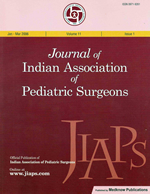
|
Journal of Indian Association of Pediatric Surgeons
Medknow Publications on behalf of the Indian Association of Pediatric Surgeons
ISSN: 0971-9261
EISSN: 0971-9261
Vol. 11, No. 1, 2006, pp. 47-50
|
 Bioline Code: ip06012
Bioline Code: ip06012
Full paper language: English
Document type: Research Article
Document available free of charge
|
|
|
Journal of Indian Association of Pediatric Surgeons, Vol. 11, No. 1, 2006, pp. 47-50
| en |
Personal Viewpoint - Definitive management of isolated esophageal atresia: Experience at NICH Karachi
Jan IftikharA, Ahmad Sophia, Arain Anwar, Soomro Aqil, Ali Mohammad, Habib Quraisha
Abstract
Background: Definitive treatment of isolated esophageal atresia (IEA) is still controversial. A study was conducted to review cases of IEA in our department with a view to evaluate the long term results of definitive surgery in these patients.
Materials and Methods: Nine consecutive patients with IEA were included in the study. All babies initially underwent cervical esophagostomy and feeding gastrostomy. One baby also had anorectal atresia and needed a colostomy. In 6 babies, end esophagostomy was performed while in 3 babies, lateral esophagostomy was performed. Of the 6 babies with end esophagostomy, two underwent jejunal Interpositioning, two had serial extra-thoracic lengthening and two reverse gastric tube interpositiong. Three babies with lateral esophagostomy were planned for delayed primary repair.
Results: Both babies with jejunal interpositiong initially did well; serious gastro-esophageal reflux occurred in one baby who needed antireflux surgery. At 6 years follow-up both children had redundant Jejunum. Recurrent Respiratory tract infection remained a problem in one child while other is doing well. Of the two babies with extrathoracic lengthening it was possible to perform end to end anastomosis in one baby but in the other extrathoracic lengthening did not work and gastric transpositioning was performed. Of the two babies with reverse gastric tube interpositioning one developed esophageal stenosis at the site of anastomosis and is on serial dilatations. Other died due to anastomotic leak and mediastinitis. In all the three babies with lateral esophagostomy spontaneous lengthening of esophagus was noted. End to end anastomosis was possible in two of these babies who are doing well. One is waiting definitive surgery. Number of complications, hospital stay and cost of surgery was least in patients with lateral esophagostomy.
Conclusion: Various methods of definitive treatment have been proposed for isolated esophageal atresia but each having its own complications. Treatment therefore has to be individualized. Lateral esophagostomy with spontaneous esophageal growth may be a good option in developing countries with limited facilities.
Keywords
Esophageal atresia, jejnunal interpositiong, esophageal substitution, lateral esophagostomy
|
| |
© Copyright 2006 Journal of Indian Association of Pediatric Surgeons.
Alternative site location: http://www.jiaps.com/
|
|
